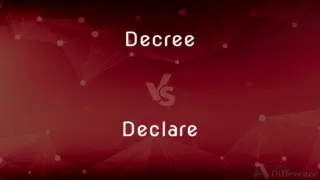Bovine vs. Ovine — What's the Difference?
By Urooj Arif & Maham Liaqat — Updated on March 17, 2024
Bovine refers to cattle; ovine pertains to sheep.

Difference Between Bovine and Ovine
Table of Contents
ADVERTISEMENT
Key Differences
The term "bovine" is used to describe animals belonging to the species of domestic cattle, as well as related animals like bison and buffalo. Bovines are known for their significant role in agriculture, providing meat (beef), dairy products, leather, and more. These animals are characterized by their large size, hooved feet, and in many cases, the presence of horns. On the other hand, "ovine" relates specifically to sheep, a distinct category of domesticated livestock. Sheep are primarily raised for wool, meat (lamb or mutton), and milk. Unlike bovines, sheep are smaller in size and are famous for their wooly fleece, which is sheared annually and used in the textile industry.
Bovine animals play a crucial part in many cultures and economies around the world, with their domestication dating back thousands of years. Sheep have been an essential part of human agriculture for millennia, with their domestication occurring around the same time as cattle.
While both bovine and ovine animals are herbivores and ruminants, meaning they have a specialized stomach to digest plant material, their dietary preferences, social behavior, and the products they provide differ significantly. Bovines tend to be larger and more solitary or live in smaller family groups compared to sheep, which are known for their flocking behavior, where they move and graze as a tight-knit group for protection against predators.
Another difference lies in their environmental adaptability and management needs. Cattle (bovines) require more grazing land per animal due to their size but are adaptable to a wide range of environments. Sheep (ovines), being smaller, can be raised in a variety of climates but often require more intensive management to protect against predators and to manage their wool.
Understanding the distinctions between bovine and ovine species is essential for agricultural practices, animal husbandry, and in various cultural contexts where these animals hold symbolic significance.
ADVERTISEMENT
Comparison Chart
Definition
Refers to cattle and related species like bison and buffalo.
Pertains to sheep.
Primary Use
Meat (beef), dairy products, leather.
Wool, meat (lamb, mutton), milk.
Physical Traits
Larger size, hooved feet, often have horns.
Smaller size, wooly fleece.
Social Behavior
More solitary or in small family groups.
Flocking behavior, moving and grazing as a group.
Agricultural Role
Significant in meat and dairy production.
Important for wool, meat, and milk production.
Domestication
Thousands of years ago for meat, dairy, and labor.
Thousands of years ago primarily for wool and meat.
Environmental Adaptability
Adaptable to a wide range of environments.
Can be raised in various climates but require protection.
Compare with Definitions
Bovine
Require significant grazing land due to size.
Sustainable bovine farming practices are essential for environmental health.
Ovine
Exhibit flocking behavior for protection.
Ovine herds often stick closely together to avoid predators.
Bovine
Known for their role in dairy and beef production.
Bovine milk is a staple in many diets worldwide.
Ovine
Sheep are primarily raised for wool, meat, and milk.
Ovine wool is highly valued for its warmth and texture.
Bovine
Relating to cattle, including cows and bulls.
The bovine herd grazed peacefully in the field.
Ovine
Smaller in size, with a distinctive wooly fleece.
Annual shearing of the ovine fleece is a key agricultural task.
Bovine
Domesticated for labor, dairy, and meat.
Ancient civilizations domesticated bovines for plowing fields as well as for food.
Ovine
Adapted to various climates but need more care.
Proper management of ovine health and welfare is critical in sheep farming.
Bovine
Characterized by their large build and often presence of horns.
Bovine breeds vary widely in size and color.
Ovine
Referring to sheep and their characteristics.
The ovine population is vital for the wool industry.
Bovine
Of, relating to, or resembling a ruminant mammal of the bovid subfamily Bovinae, such as a cow, ox, or buffalo, especially one in the genus Bos.
Ovine
Of, relating to, or characteristic of sheep; sheeplike.
Bovine
Sluggish, dull, and stolid.
Ovine
A sheep.
Bovine
An animal of the subfamily Bovinae, especially one of the genus Bos.
Ovine
(comparable) Of, being, pertaining to, or resembling a sheep; also, (not comparable) of an animal: from the genus Ovis.
Bovine
(not comparable) Of or pertaining to cattle.
Ovine
Resembling a sheep in character; acquiescent, easily influenced, passive, or willing to follow a leader blindly.
Bovine
(not comparable) Belonging to the family, subfamily, tribe, or genera including cows, buffalo, and bison.
Ovine
An animal from the genus Ovis; a sheep.
Bovine
Sluggish, dull, slow-witted.
Ovine
(figuratively) A person regarded as resembling a sheep in character; one who is acquiescent, easily influenced, passive, or willing to follow a leader blindly; a sheep.
Bovine
An animal of the family, subfamily, tribe, or genera including cattle, buffaloes and bison.
Ovine
Of or pertaining to sheep; consisting of sheep.
Bovine
Of or pertaining to the genus Bos; relating to, or resembling, the ox or cow; oxlike; as, the bovine genus; a bovine antelope.
Ovine
Of or pertaining to or of the nature of or characteristic of a sheep or sheep
Bovine
Having qualities characteristic of oxen or cows; sluggish and patient; dull; as, a bovine temperament.
The bovine gaze of gaping rustics.
Bovine
Any of various members of the genus Bos
Bovine
Of or relating to or belonging to the genus Bos (cattle)
Bovine
Dull and slow-moving and stolid; like an ox;
Showed a bovine apathy
Common Curiosities
How do the dietary needs of bovines and ovines differ?
While both are herbivores and ruminants, they may have different specific dietary needs based on their size, the quality of pasture available, and the production goals (meat, milk, wool).
Can bovines and ovines coexist in the same habitat?
Yes, bovines and ovines can coexist and are often raised together in mixed livestock farming, benefiting from their different grazing habits.
Are bovine or ovine animals easier to raise?
The ease of raising bovines or ovines depends on the specific farming goals, available resources, and environment. Sheep require more protection and management for their wool, while cattle require more land per animal.
What are the environmental impacts of raising bovines vs. ovines?
Both have environmental impacts, including land and water use. Bovines generally have a larger carbon footprint due to their size and the methane they produce, while ovines, though smaller, still require careful management to minimize environmental impacts.
What distinguishes bovine from ovine animals?
Bovines refer to cattle and their relatives, known for meat, dairy, and labor, whereas ovines pertain to sheep, known for wool, meat, and milk.
Which has a longer history of domestication, bovine or ovine animals?
Both bovines and ovines have been domesticated for thousands of years, with their domestication occurring around the same time but independently for different purposes.
How do the social structures of bovine and ovine herds differ?
Bovines tend to be more solitary or form smaller family groups, while ovines exhibit strong flocking behavior, moving and grazing as a tight-knit group for protection.
What roles do bovines and ovines play in traditional cultures?
In many cultures, bovines have been symbols of wealth and plow animals for agriculture, while ovines have been central to pastoral and nomadic lifestyles, especially for their wool and meat.
What are the genetic diversity implications of domestic bovine and ovine breeds?
Domestication and selective breeding have led to a wide variety of bovine and ovine breeds, each adapted to specific climates and purposes. Preserving genetic diversity is key to resilience and adaptability of these livestock populations to changing environments.
Can bovine and ovine animals be used in sustainable farming practices?
Yes, both can be integral to sustainable farming systems. Bovines can help with land management and fertilization, while ovines are effective in weed control and maintaining pasture health through their grazing patterns.
What are the main health concerns for bovine and ovine livestock?
Bovines often face issues like bovine respiratory disease and foot rot, while ovines can be susceptible to parasitic infections and footrot. Proper veterinary care and management practices are crucial for both.
How does the wool from ovine animals compare to other textiles?
Ovine wool is renowned for its durability, warmth, and breathability, making it superior to many synthetic textiles, especially in cold weather clothing and sustainable fashion.
Share Your Discovery

Previous Comparison
Decree vs. Declare
Next Comparison
Cacti vs. CactusAuthor Spotlight
Written by
Urooj ArifUrooj is a skilled content writer at Ask Difference, known for her exceptional ability to simplify complex topics into engaging and informative content. With a passion for research and a flair for clear, concise writing, she consistently delivers articles that resonate with our diverse audience.
Co-written by
Maham Liaqat













































